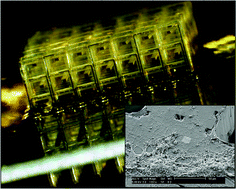Abstract
This work demonstrated the design, fabrication, packaging, and characterization of an active microscaffold system with fluid perfusion/

a School of Electrical and Computer Engineering, Georgia Institute of Technology, 791 Atlantic Drive, Atlanta, GA 30332, USA
b Departments of Neurology and Medical Microbiology, Immunology and Cell Biology, Southern Illinois University School of Medicine, IL 62702, USA
c Department of Electrical and Computer Engineering, University of Illinois at Urbana-Champaign, 2351 Beckman Institute, 405 N. Mathews Ave, Urbana, IL 61801, USA
d School of Mechanical Engineering, Georgia Institute of Technology, 801 Ferst Drive, Atlanta, GA 30332, USA
This work demonstrated the design, fabrication, packaging, and characterization of an active microscaffold system with fluid perfusion/

 Please wait while we load your content...
Something went wrong. Try again?
Please wait while we load your content...
Something went wrong. Try again?
L. Rowe, M. Almasri, K. Lee, N. Fogleman, G. J. Brewer, Y. Nam, B. C. Wheeler, J. Vukasinovic, A. Glezer and A. B. Frazier, Lab Chip, 2007, 7, 475 DOI: 10.1039/B700795G
To request permission to reproduce material from this article, please go to the Copyright Clearance Center request page.
If you are an author contributing to an RSC publication, you do not need to request permission provided correct acknowledgement is given.
If you are the author of this article, you do not need to request permission to reproduce figures and diagrams provided correct acknowledgement is given. If you want to reproduce the whole article in a third-party publication (excluding your thesis/dissertation for which permission is not required) please go to the Copyright Clearance Center request page.
Read more about how to correctly acknowledge RSC content.
 Fetching data from CrossRef.
Fetching data from CrossRef.
This may take some time to load.
Loading related content
